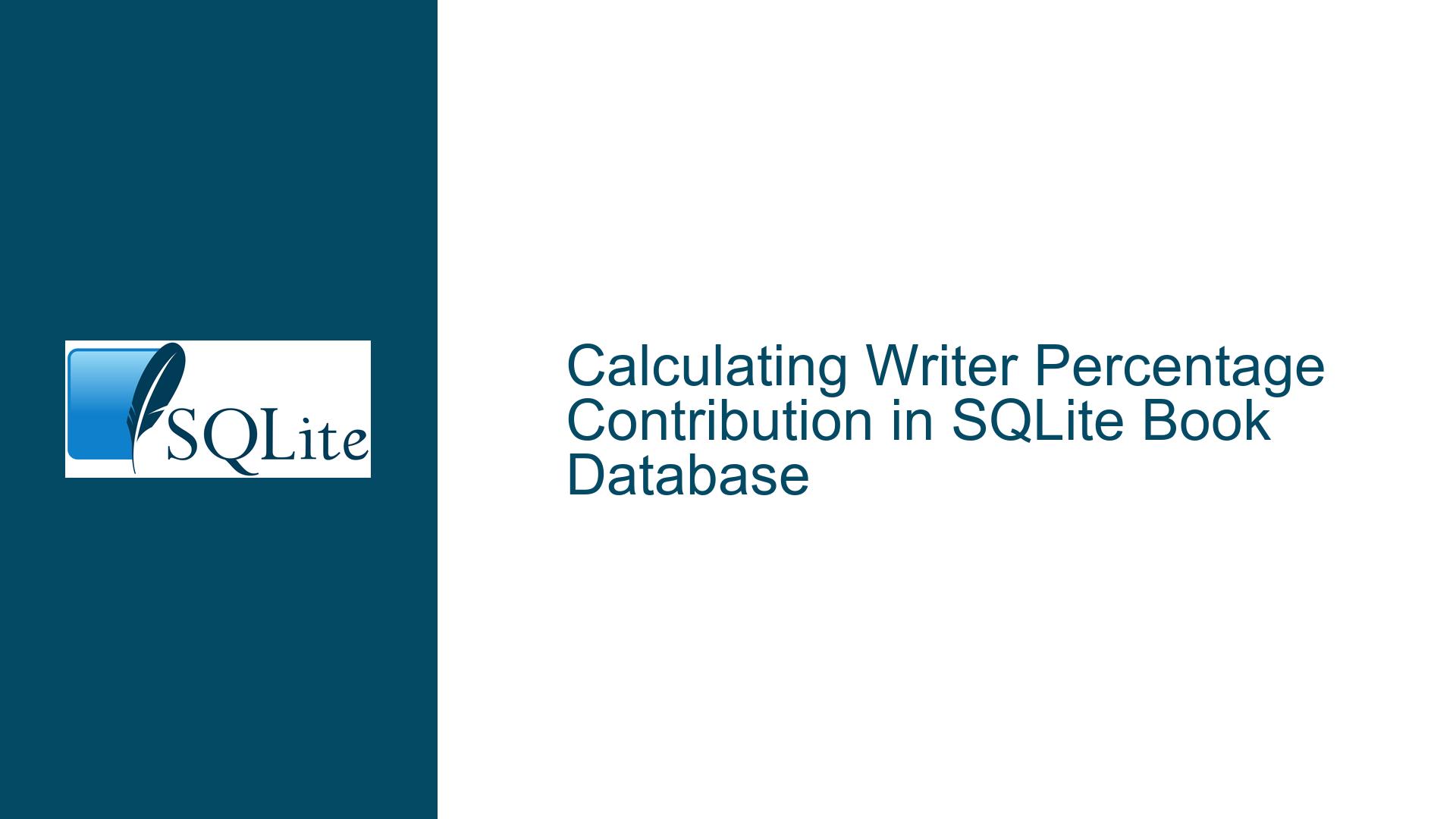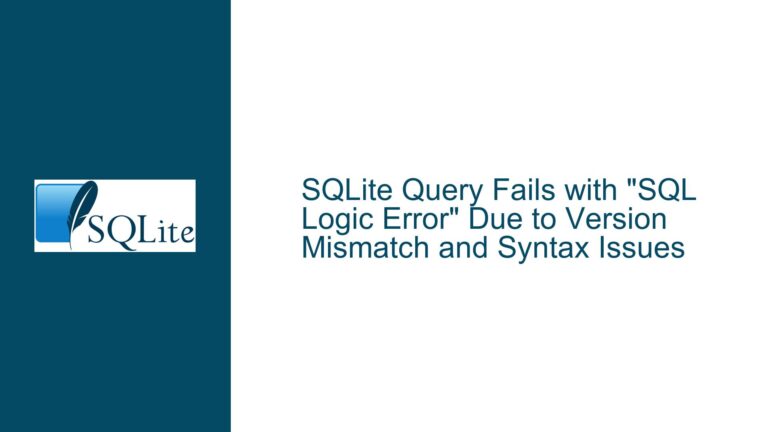Calculating Writer Percentage Contribution in SQLite Book Database
Understanding Percentage Calculation for Writers in SQLite Views
Core Challenge: Computing Writer-Specific Proportions Relative to Total Books
The primary objective is to create a view that calculates the percentage of books attributed to each writer relative to the entire collection. The existing view (NumberOf_Title_Writer) successfully counts titles per writer but lacks the contextualization of these counts as proportions of the total. The challenge lies in integrating a scalar total book count into a grouped aggregation while avoiding common pitfalls such as incorrect subquery scoping, integer division errors, and misapplication of aggregate functions.
Root Causes of Percentage Calculation Errors
- Misunderstanding Scalar vs. Aggregated Subqueries: Attempting to compute the total book count within a grouped query without isolating it as a scalar value leads to incorrect results or syntax errors.
- Integer Division Truncation: Using integer arithmetic (e.g.,
COUNT(*) / COUNT(*)) without explicit type casting to floating-point values causes percentage values to truncate to zero or whole numbers. - Incorrect Subquery Placement: Embedding a subquery that references the outer query’s
Writerfield inadvertently creates a correlated subquery, resulting in unintended grouping or scalar context mismatches. - Ambiguity in Grouping Logic: Omitting
GROUP BYclauses in subqueries intended to compute global totals introduces partial aggregations that skew percentage calculations.
Step-by-Step Solutions for Accurate Percentage Views
Step 1: Isolate Total Book Count as a Scalar Value
The total number of books must be computed independently of the per-writer groupings. This is achieved using a non-correlated subquery that executes once and returns a single value:
SELECT
Writer,
100.0 * COUNT(*) / (SELECT COUNT(*) FROM Books) AS Percentage
FROM Books
GROUP BY Writer;
- Critical Insight: The subquery
(SELECT COUNT(*) FROM Books)is evaluated once, producing a constant scalar value used across all grouped rows.
Step 2: Ensure Floating-Point Arithmetic
Explicitly using 100.0 instead of 100 forces floating-point division, preventing integer truncation. For example:
-- Incorrect (integer division):
100 * COUNT(*) / (SELECT COUNT(*) FROM Books) -- Yields 0 for small counts
-- Correct (floating-point):
100.0 * COUNT(*) / (SELECT COUNT(*) FROM Books) -- Preserves decimal precision
Step 3: Validate Subquery Independence
Verify that the total count subquery does not inadvertently reference the outer query’s context. For instance, the following erroneous subquery would fail:
-- WRONG: Correlated subquery
100.0 * COUNT(*) / (SELECT COUNT(*) FROM Books WHERE Writer = Books.Writer)
This mistake would compute per-writer counts instead of the global total, nullifying the percentage logic.
Step 4: Alternative Structural Approaches
For readability or performance optimization, consider these equivalent formulations:
Method A: Cross-Join with Derived Table
SELECT
Writer,
100.0 * COUNT(*) / TotalBooks AS Percentage
FROM Books
CROSS JOIN (SELECT COUNT(*) AS TotalBooks FROM Books)
GROUP BY Writer;
- Advantage: Separates the total count computation into a named derived table, improving readability.
Method B: Common Table Expression (CTE)
WITH Total AS (SELECT COUNT(*) AS TotalBooks FROM Books)
SELECT
Writer,
100.0 * COUNT(*) / TotalBooks AS Percentage
FROM Books, Total
GROUP BY Writer;
- Advantage: Uses CTEs for modularity, making the query structure self-documenting.
Step 5: Rounding and Formatting
To enhance presentation, wrap the percentage calculation in the ROUND function:
CREATE VIEW PercentageOf_Title_Writer AS
SELECT
Writer,
ROUND(100.0 * COUNT(*) / (SELECT COUNT(*) FROM Books), 2) AS Percentage
FROM Books
GROUP BY Writer;
- Precision Handling: Rounding to two decimal places balances readability with accuracy.
Step 6: Edge Case Handling
- Empty Table Scenario: If the
Bookstable is empty, the subquery(SELECT COUNT(*) FROM Books)returns0, leading to division by zero. Mitigate this usingNULLIF:100.0 * COUNT(*) / NULLIF((SELECT COUNT(*) FROM Books), 0) - NULL Writers: Rows with
NULLin theWriterfield are grouped separately. Exclude them if undesired:SELECT Writer, ... FROM Books WHERE Writer IS NOT NULL GROUP BY Writer;
Step 7: Performance Considerations
- Subquery Caching: SQLite optimizes static subqueries (e.g.,
SELECT COUNT(*) FROM Books) by executing them once, even if referenced multiple times. - Indexing: While
COUNT(*)operations on SQLite tables are generally efficient, ensure theBookstable has appropriate indexes if filtering is involved (e.g.,WHERE Writer IS NOT NULL).
Step 8: Verification with Sample Data
Test the solution with a controlled dataset to confirm correctness:
CREATE TABLE Books (Book TEXT, Writer TEXT);
INSERT INTO Books VALUES
('Book0', 'X'), ('Book1', 'X'), ('Book2', 'X'),
('Book3', 'Z'), ('Book4', 'Y'), ('Book5', 'Z'),
('Book6', 'Y'), ('Book7', 'Y');
Executing the percentage view should yield:
Writer | Percentage
X | 37.5
Y | 37.5
Z | 25.0
- Validation: Confirm that percentages sum to approximately 100% (allowing for rounding errors).
Final Implementation
The optimized view definition incorporating all considerations:
CREATE VIEW PercentageOf_Title_Writer AS
SELECT
Writer,
ROUND(100.0 * COUNT(*) / NULLIF((SELECT COUNT(*) FROM Books), 0), 2) AS Percentage
FROM Books
WHERE Writer IS NOT NULL
GROUP BY Writer
ORDER BY Percentage DESC;
This implementation ensures robustness against edge cases, clarity in presentation, and adherence to SQLite best practices.






